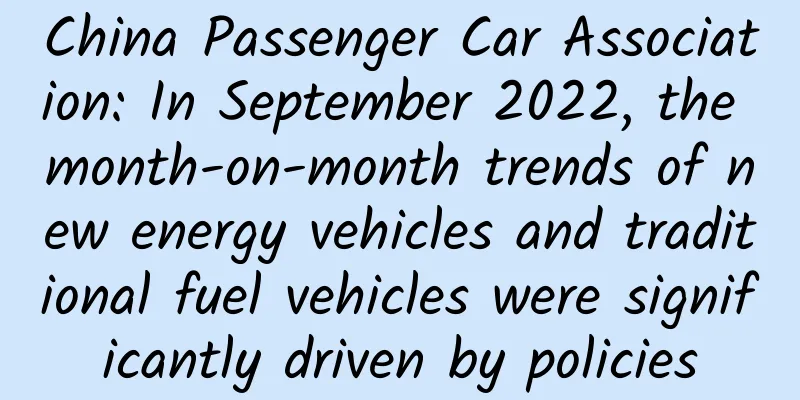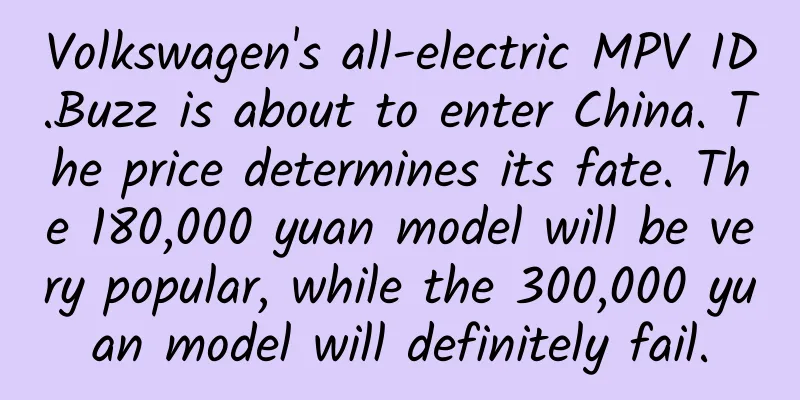China Passenger Car Association: In September 2022, the month-on-month trends of new energy vehicles and traditional fuel vehicles were significantly driven by policies

|
According to the new energy vehicle retail data of the China Passenger Car Association, after the implementation of the policy of halving the purchase tax on fuel vehicles, the national new energy vehicle market was not only not affected, but the trend of new energy vehicles from June to September exceeded expectations. The supply improvement and the increase in oil prices have brought a hot market. The increase in oil prices and the lock-in of electricity prices have driven the hot performance of electric vehicle orders. The policies issued by various regions to encourage the consumption of passenger cars are strong. The month-on-month trends of new energy vehicles and traditional fuel vehicles in September were significantly driven by policies. 1. New energy vehicle wholesale is very strong in September In September, wholesale sales of new energy passenger vehicles reached 675,000 units, up 95% year-on-year and 12% month-on-month. Under the policy of halving the vehicle purchase tax, new energy vehicles were not only not affected, but also continued to improve month-on-month, exceeding expectations. The trend from January to September showed a continuous upward trend, and the market's hot growth momentum has not faded. From January to September, the wholesale volume of new energy passenger vehicles reached 4.33 million, a year-on-year increase of 115%. Since the beginning of this year, the price of power batteries has risen much faster than expected due to the price increase of raw materials such as lithium and nickel. Therefore, after the price increase of power batteries, automakers are under great pressure and can only ease the cost pressure by raising prices. The impact of the previous two rounds of new energy vehicle price increases is not obvious for the time being, and the price increase in September has no obvious impact. First of all, the sales model of new energy vehicles is order sales. At present, various car companies have a large number of orders before the price increase, resulting in the digestion of previous orders from March to May. In June, local consumption promotion policies were promoted, among which new energy vehicles had special preferential treatment, and the current new energy sales are further hot. Secondly, the new energy plug-in hybrid has diverted the fuel vehicle market, and high oil prices have increased the advantages of new energy. Under the current high oil prices, the cost performance of new energy vehicles has been significantly improved, but the traditional vehicle market has become more difficult. The third reason is that consumers have strong rigid demand for new energy vehicles and relatively low price sensitivity, so a small price change will not significantly affect consumers' demand for new energy vehicles. The fourth reason is that the order price of new energy vehicles was locked before the price increase, resulting in a locked-in price for early orders, which led to a new situation in which more consumers were rational or followed suit to rush to order. Car companies have also taken measures to regulate the order of suspected scalpers. 2. New energy vehicle retail sales growth rate was strong in September In September, the retail sales of new energy passenger vehicles reached 611,000 units, an increase of 83% year-on-year and 9% month-on-month, forming a trend of upward trend from January to September. From January to September, the domestic retail sales of new energy passenger vehicles basically had no seasonal pattern, and the trend within the quarter was also strong. According to the retail data of the China Passenger Car Association, the domestic sales of new energy passenger vehicles from January to September reached 3.87 million, a year-on-year increase of 113%. The current annual cumulative growth rate remains high. The forecast for new energy vehicles in the fourth quarter is relatively conservative, mainly because the strong performance in the third quarter made up for the losses in the second quarter. At the beginning of the fourth quarter, we need to consider adjusting the annual forecast. 3. Usage characteristics of new energy passenger vehicles The proportion of new energy passenger car rental and leasing gradually increased from 2017 to 2019, and then the proportion of pure electric rental and leasing continued to decline starting in 2020. Due to insufficient supply in the private market, the proportion of pure electric rental and leasing in September 2022 was 12%, a significant increase from the beginning of the year. Recently, the private market share of plug-in hybrids has continued to increase, while the demand for plug-in hybrids for rental has continued to decline. Pure electric vehicles are still the best choice for rental. 4. Regional market performance is gradually improving In the past few years, the demand for new energy passenger vehicles was strong mainly in megacities with purchase restrictions, but has continued to decline recently. From January to September 2022, new energy passenger vehicles accounted for 22% of total sales in megacities, down 7 percentage points from 2021. This also shows that the sales growth rate of new energy vehicle market in cities with purchase restrictions has gradually slowed down, and the basic population size has constrained demand. Due to the large population base and poor public transportation, new energy in the county and township markets has gradually started recently. Compared with the gradual extension of fuel vehicles to low-tier markets, the pace of new energy vehicles is faster, especially in large cities without purchase restrictions, where new energy vehicle sales have reached a relatively high share. New energy vehicles in county and township markets are also gradually expanding, with great potential in the future. 5. The performance of the new energy urban market is gradually improving The main growth drivers of new energy vehicles in September were the hardest-hit areas that were suppressed in the early stage of the epidemic, and the restricted purchases in Shanghai, Hangzhou, Shenzhen and other places still performed well. The main growth drivers of new energy vehicles in September also included Zhengzhou, Wuhan and other core cities without purchase restrictions. From January to September 2022, new energy vehicles saw a significant increase across the board compared to the same period in 2021. The growth in Chengdu, Hangzhou, Foshan, Shenzhen and other cities was relatively rapid, especially Chengdu, where the increase reached 60,000 units, forming the core driving force for the increase. The Chengdu market is also a unique environment for new energy vehicles to show high growth. Products with high appearance and low use costs have great potential in the southwest region. Hangzhou, Shenzhen, Guangzhou and other cities with purchase restrictions have relatively strong performance, which is also the incremental contribution of high-end models in cities with purchase restrictions. 6. Regional differences in demand for pure electric vehicles The gradual launch of the pure electric private household market has promoted the development of the industry. Although the demand in large cities with purchase restrictions is very strong this year, the proportion has gradually decreased, the market share of large restricted cities has continued to rise, and the private consumption market in small and medium-sized cities and county and township markets has recovered slowly. The pure electric vehicle leasing market is currently showing a gradual recovery. In 2019, the proportion of rental leasing in pure electric vehicle sales reached its peak, and then the proportion of rental leasing gradually declined in 2020. In 2022, the performance dropped to around 14%, but was stronger in September. The proportion of rental cars in megacities has declined, while the private market is still recovering rapidly. The rental market in cities with purchase restrictions is still the core force this year. From the performance of the main models, it also reflects the improvement of the performance of the main models in large and medium-sized cities. In particular, the increase in BYD in September, compared with the same period, the increase in share was 2 percentage points in large cities and medium-sized markets. From the perspective of Tesla, the main areas in September extended to small cities compared with the same period, and the pure electric market in medium-sized cities grew relatively well. 7. Regional demand for plug-in hybrid passenger vehicles The private consumption market for plug-in hybrid vehicles has great potential for growth, and there is good demand in both small and medium-sized cities. The proportion of plug-in hybrid vehicles in unit use and rental continues to shrink. The main demand for plug-in hybrid rental models is in the megacities and large cities, and this year's megacities have seen a significant decline in plug-in hybrid rentals. In recent years, the proportion of plug-in hybrid vehicles in cities without purchase restrictions has gradually increased, and BYD and Ideal are relatively strong. The M5 performed very well in September, surpassing some old star models. Plug-in hybrids strengthened in September, and large and medium-sized cities with or without purchase restrictions are still the main force of plug-in hybrids. The demand in cities with purchase restrictions has been greatly affected by the epidemic, and plug-in hybrids in county and township markets have not yet been fully and effectively promoted. BYD Han and other models have a high degree of dependence in cities with purchase restrictions. Low-priced plug-in hybrids such as Qin and Song perform well in small and medium-sized cities. 8. Regional penetration of electric passenger vehicles – September At present, the proportion of pure electric vehicles in cities with purchase restrictions has increased significantly, from 6% in 2019 to 30% in 2022. The sales share of pure electric vehicles of new energy vehicles in large cities, medium-sized cities and small cities without purchase restrictions is basically the same. In 2019 and 2020, it was at a relatively low level. In September this year, it rose to 22% in medium-sized cities, and the penetration improvement in county and township markets was also strong. In 2021, the national plug-in hybrid market also reached a recent high of 6%. The penetration rate of plug-in hybrids in various parts of the country has continued to grow, especially in megacities, where the plug-in hybrid market accounted for 12% in September this year. Among them, the proportion of the plug-in hybrid market in small cities has also shown a continuous increase, and the gap in plug-in hybrid penetration rates between various cities has narrowed relatively. 9. In September, the companies in each regional market were highly differentiated. The performance of the rental markets in various regions varies greatly. The rental markets with strong performance in September this year are Guangdong, Zhejiang, Jiangsu, etc. Among them, the performance of various manufacturers in the rental markets in various regions is also quite different. In some regions, the share of local products in the local rental market is not necessarily very high. For example, in the Sichuan market and the Chongqing market, foreign brands have performed relatively well this year. The private pure electric market has relatively distinct characteristics, and the trend towards high-end is extremely obvious. BYD performs well and is basically the first in developed regions. SAIC-GM-Wuling in Guangxi and Shandong is relatively strong. New car manufacturers such as NIO and Xpeng Motors have performed very well, while traditional car manufacturers have also performed well in the private electric vehicle market. BYD and Ideal Auto performed well in the private plug-in hybrid market. In particular, BYD is almost fully ahead in major cities. Ideal Auto's performance in most major markets declined. Jinkang Celis has surpassed Ideal Auto in Jiangsu, Guangdong, Zhejiang, Shandong, Sichuan and other markets, and SAIC Passenger Cars is also performing well. The plug-in hybrid performance of joint venture automakers is relatively weak, while BMW and Volkswagen Group China and Volkswagen Group China performed slightly better. 10. Beijing market trends The trend of the new energy vehicle market in Beijing in 2022 was relatively stable, with sales reaching 19,000 units in September 2022, slightly higher than the same period last year. However, Beijing's sales in January 2022 were much lower than last year, and the cumulative sales from January to September increased by 23% year-on-year, which was average. Since the new energy vehicle quotas became relatively tight in 2018, the Beijing new energy vehicle market in 2022 has been in contrast to the national trend. This is the effect of suppressed consumption caused by the rhythm of quota issuance. Beijing's new energy vehicle sales in June-September were relatively good. Considering the lack of quotas and the small supply of Tesla vehicles, Beijing's performance in September was relatively stable. Beijing's new energy vehicle grades are generally pragmatic, which is also a reflection of the good demand for home use. 11. Trends in Shanghai’s new energy market The new policy trend in the Shanghai market is in sharp contrast to that in the Beijing market, which has been extremely stable since 2019. Starting from September 2020, new energy vehicles in Shanghai have shown a small explosive growth feature. In September 2022, the sales volume of new energy vehicles in Shanghai reached less than 46,000 units, a slight increase compared to 28,000 units in September last year. The losses suffered by Shanghai's new energy vehicles due to the epidemic in September should be able to recover significantly in the future. 12. Market trends of new energy passenger vehicles in restricted cities New energy vehicles performed relatively well in restricted cities, reaching 134,000 units in September 2022, a year-on-year growth rate of 60%. In addition, the cumulative sales of new energy vehicles from January to September reached 908,000 units, a year-on-year growth of 131%, which is much higher than our overall auto market growth and higher than the average growth rate of our overall new energy vehicles, reflecting the relatively high enthusiasm for purchasing new energy vehicles in restricted cities under the epidemic. 13. Market trends of new energy passenger vehicles in areas with no purchase or driving restrictions Non-double-restricted cities are what we call areas where fuel vehicles are not restricted in purchase and driving. Since traditional vehicles are not restricted in purchase and driving, the demand for new energy vehicles in these cities is real market demand. At present, non-double-restricted cities are also growing extremely rapidly. Such cities are relatively widespread in the country, and the sales of new energy vehicles are currently at a relatively high level. In 2022, new energy vehicles performed extremely well in non-double-restricted cities, with sales of 263,000 units in September, a year-on-year growth rate of 71%. Overall, the cumulative sales from January to September reached 1.87 million units, a year-on-year increase of 129%, showing a strong growth trend. Cities without purchase restrictions or driving restrictions, which were not affected by the policy in the early stage, have become the main force of sales and growth. All regions in the country have the characteristics of strong demand growth for new energy vehicles. Combined with the demand of cities with driving restrictions, regional market demand in 2022 will maintain strong growth. |
<<: JD Power: 2022 China New Energy Vehicle Customer Experience Value Research
Recommend
Detailed explanation of Android's official Kotlin-First image loading library
Preface Coil is a very young image loading librar...
Six intelligent prospects for the development of the Internet of Things
No one knows exactly how many things in the world...
There is a mahjong table in the train, where you can play cards and sing karaoke? Here comes the response!
Recently, in Xi'an, a video of "playing ...
Xiaomi App Store Ads Creative Label Settings
"Except for Apple, Xiaomi's user quality...
Zhihu and Xiaohongshu traffic and algorithm logic
In many people's impressions, Zhihu's mai...
Why does a word seem strange after staring at it for too long? Maybe the brain wants to “fuck off”
...
All the strategies for advertising on new media platforms in 2018 are here!
According to the data from the "2018 China O...
The turtles that appeared in groups on the river bank are not actually that many...
Not long ago, a piece of news like this became a ...
Is “use it and leave it” outdated? Lessons from the Battle Between Two Giants of Android Optimization Tools
Zhang Xiaolong said in a public speech last year ...
Why do so many brands do year-end reviews, and NetEase and Alipay dominate the screen?
It is the end of the year again, and brands from ...
How to write an excellent marketing creative plan?
When it comes to creativity, it is difficult for ...
5.5-inch iPhone 6 is not available even if you have money
iPhone 6 and iPhone 6 Plus will soon be launched ...
I really want to ask: My partner has a very loud voice, will it damage my hearing?
Have you ever encountered a situation where someo...
TSMC has manufactured over 1 billion 7nm chips (with original text)
Recently, TSMC announced on its official blog tha...
Why do I feel uncomfortable if I don’t drink coffee for a day?
Author: Hao Yun Reviewer: Zhong Kai, Director of ...









